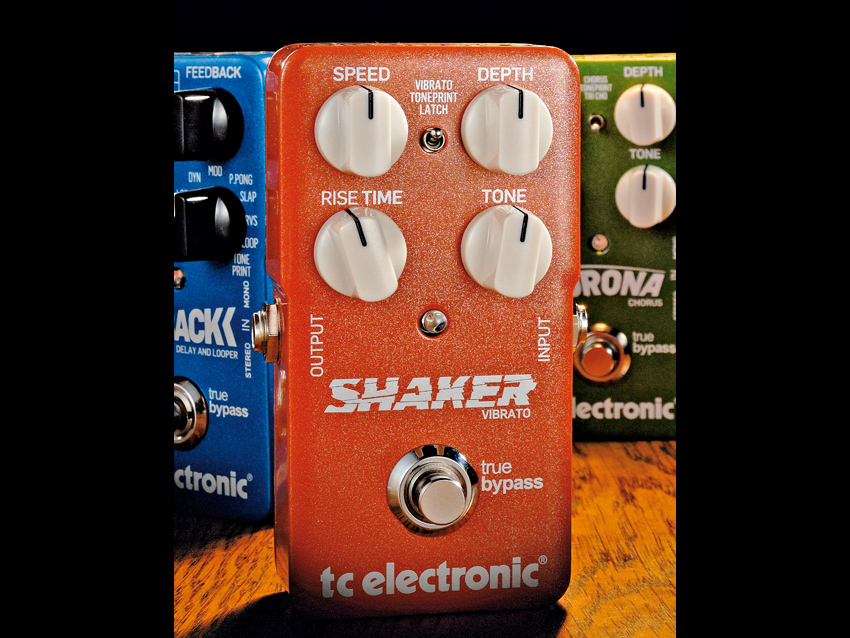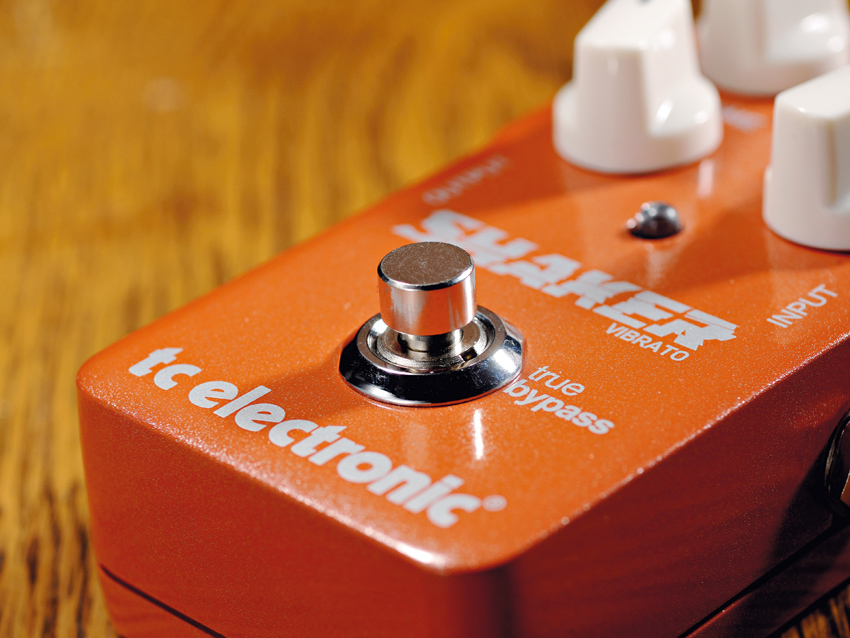MusicRadar Verdict
A cool pedal with an effect that's not heard as much as other modulation effects, but deserves to be.
Pros
- +
TonePrint function. Latch mode. Broad tonal range.
Cons
- -
Nothing.
MusicRadar's got your back

TC Electronic Shaker

Shaker close-up view
Denmark's TC Electronic is an effects legend. The last few years have seen the brand branching out into an innovative range of floor- and pedal-based products, including the genre-changing PolyTune pedal tuner and the successful Nova series stompboxes.
The Novas can be quite complex in operation, however, with scrolling memories, double footswitches, 12V power and so on, so the company has now launched a new range of pedals that are very much the opposite.
"The Shaker's Latch function is brilliant for adding vibrato just when and where you want it."
Build
Here we're talking straight-up, simple stompboxes. You get a compact digital pedal that can run from a 9V battery or DC adaptor. Battery access is by removing the pedal baseplate via a large chromed knurled screw that needs a coin or screwdriver to initially loosen it.
Inside, there's a pair of DIP switches - one that selects a high quality buffer rather than the default true bypass switching mode (which is useful if the pedal is at the start or end of a long chain) and a second that offersdry kill for effect only, when the pedal is to be used in an amp's FX loop.
The default setting is for analogue dry through signal, where the dry part of the signal isn't converted and passes through the pedal at all times, even when the effect is active.
The pedal has four knobs, plus a three-way switch, and features selectable effects variations.
In designing the pedal, TC wanted something that was fast, easy and intuitive to use, with the ability to change sounds on the fly with a few knob tweaks.
However, it was also aware that most stompboxes have a core sound - a basic tonality that's purely their own. Something that's fine if you like it, but that you're also unable to change if you grow tired of it. With this in mind, it set about building in a feature to allow access to a number of alternative sounds.
This feature is called TonePrint: the pedal has a USB connection that allows you to import a new sound, a custom 'tuning' of the pedal, from a computer and store it in a special onboard memory slot called up by the TonePrint position of the pedal's three-way switch (or the rotary switch in the case of the delay).
TC has made a number of these alternative 'tunings' available for each pedal, all easily accessed and downloaded into it from a special TonePrint website.
And these aren't just voicings created by some Scandinavian boffin in a white lab coat. Instead, TC has asked a bunch of the world's best guitar players to make TonePrints for the pedals.
The company has given them a specially developed tuning software that allows them to tweak every single aspect of the pedals - parameter settings, what range the pots should have, what the min-mid-max values should be, and so on, to make their own perfect pedal.
The first position of the Shaker's three-way switch offers vibrato that can be turned on and off with the footswitch, but there's also a latch position, which allows the footswitch to apply the vibrato effect as long as you hold it down.
The central position of the three-way switch calls up the selected TonePrint sound.
Sounds
Delivering smooth undulating pitch fluctuation, the Shaker offers cool vibrato sounds and can do a pretty good rotary speaker emulation.
There's plenty of variation available - the speed and depth knobs work as you'd expect, but the tone knob changes the effect's emphasis on high and low frequencies letting you really focus in on sounds that will sit just right with your tone.
The latch function is brilliant for adding vibrato just where and when you want it. It's particularly effective on a sustained note or chord - a 'rise time' knob determining how long it takes for the vibrato to reach its specified depth to provide the full effect.
Trevor Curwen has played guitar for several decades – he's also mimed it on the UK's Top of the Pops. Much of his working life, though, has been spent behind the mixing desk, during which time he has built up a solid collection of the guitars, amps and pedals needed to cover just about any studio session. He writes pedal reviews for Guitarist and has contributed to Total Guitar, MusicRadar and Future Music among others.
What’s the buzz? Meet Yellowjacket, Cherry Audio's recreation of EDP’s trend-setting Wasp from 1978
“A fabulous trip through all eight songs by 24 wonderful artists and remixers... way beyond anything I could have hoped for”: Robert Smith announces new Cure remix album
“He knows what I'm thinking and feeling before I even know it": Billie Eilish suggests that she and brother Finneas can read each other's minds










